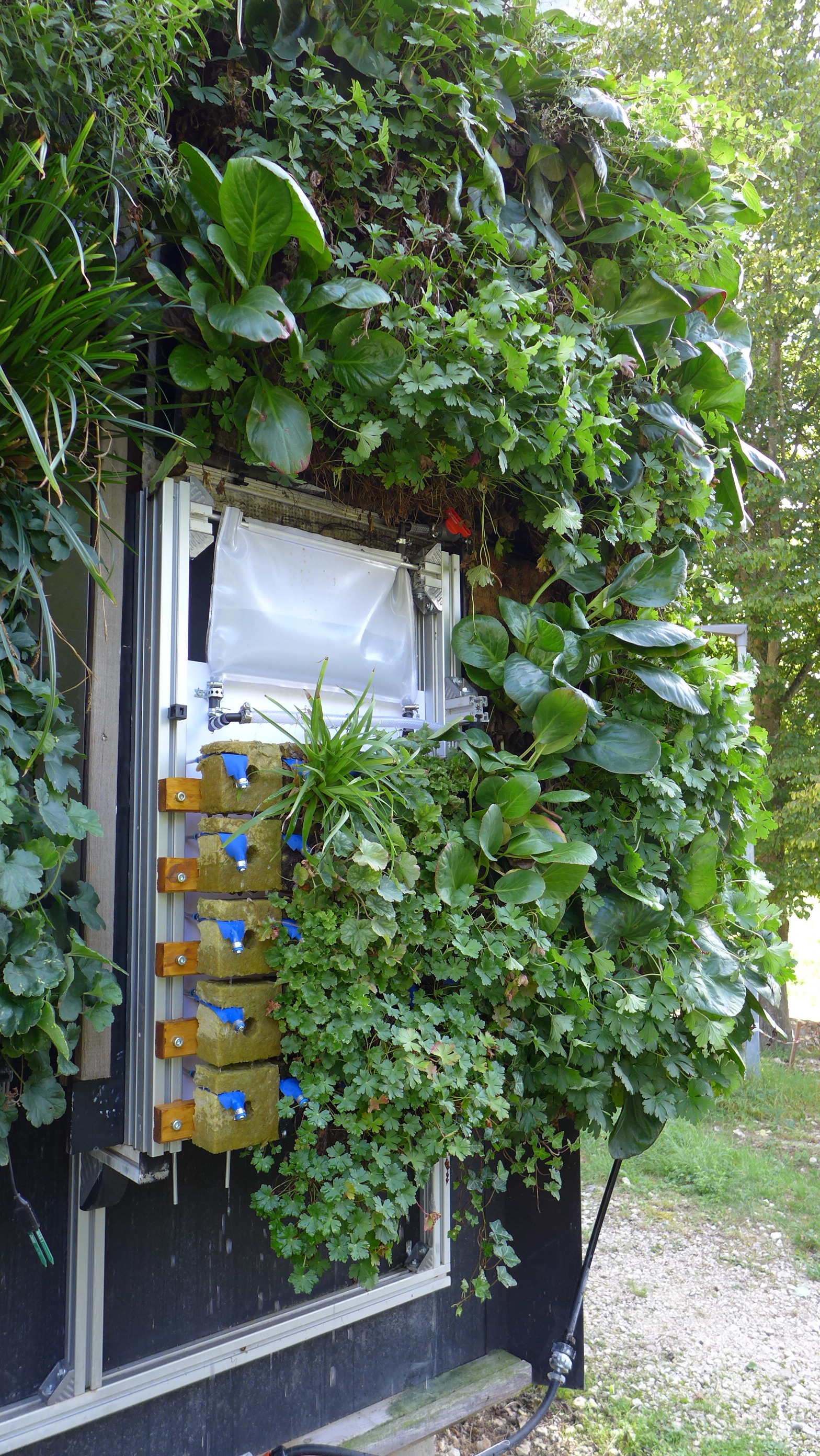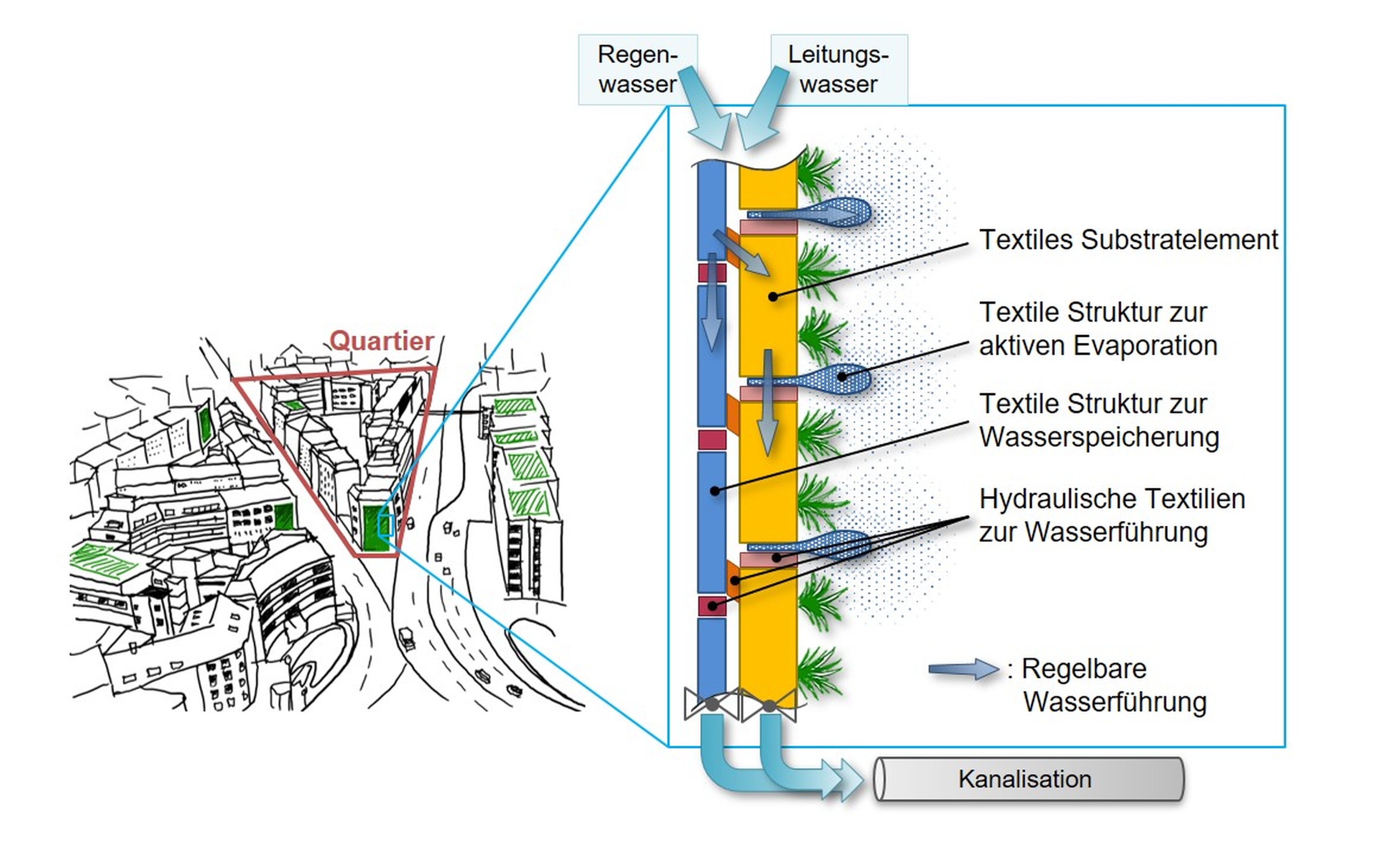Main navigation
Rain-retaining living walls improve the urban climate and protect against flooding
Due to dense urbanisation and associated soil sealing, heat and heavy rainfall are becoming an increasing problem for people living in cities. Researchers at the German Institutes of Textile and Fibre Research (DITF) in Denkendorf have developed innovative living walls that not only help cool the environment, but also provide flood protection thanks to their water retention properties.

The trend towards suburbanisation has been increasing in Germany for some years now; people from large cities with populations of over 100,000 are increasingly moving out of the compact city to suburbs.1) Families in particular are moving out of cities when they cannot find adequate and affordable housing in city centres. Living conditions in city centres are also becoming increasingly unpleasant due to climate change: temperatures are rising and storms with heavy rainfall often push sewage systems to their limits. This problem must therefore be taken into account when building new homes. "Until now, there has been a lack of technical solutions for social and high-quality redensification," explains Christoph Riethmüller from the German Institutes of Textile and Fibre Research (DITF) in Denkendorf. "Living space must be affordable, but also liveable. We see our living walls as a key enabler for successful redensification."
Living walls prevent heat island effect
In a project called "Rain-retaining living walls as an enabler of redensification through active management of surface water and quantifiable green value as a compensation area (IGF 21118 N)", Riethmüller and his team from the Smart Living Textiles Technology Centre, together with the Centre for Management Research at the DITF, have laid the foundations for largely autonomous wall greening systems. The project was funded by the German Federal Ministry for Economic Affairs and Energy [editor's note: now known as the Federal Ministry for Economic Affairs and Climate Protection] in the period from 1 June 2020 to 31 May 2022 as part of the Industrial Collective Research (iGF) programme, which builds a bridge between basic research and commercial application.
We have constructed a demo living wall as a basis for subsequent product developments," explains the engineer. "Cities need to become greener. In addition to improving the quality of life, we primarily want to create areas that reduce the formation of heat islands." So-called urban heat islands (UHI) occur in summer temperatures in areas with high soil sealing and many concrete buildings. Instead of reflecting the sunlight, the materials absorb energy, store heat and make the buildings hotter. "Facades have a huge potential to be used as living walls; plant growth improves the walls’ reflective properties and also has a cooling effect as a result of the photosynthetic activities of plants and their release of water."
Retention-capable textile structures as a basis
In contrast to other greening systems, the living walls developed at the DITF are intended to be connected to house roofs or adjacent cisterns and supplied primarily with rainwater. This is a prerequisite for another important feature: rainwater retention. Because, during heavy rain, the often-outdated sewage system in cities is quickly overwhelmed. "In new development areas, rainwater retention basins or percolation tanks can be used to control the amount of precipitation that enters the sewer system. This is not always possible in existing buildings. We have therefore focussed on retention-capable (i.e. rain-retaining) living walls."
This function is achieved with the help of textile storage structures. The plants grow on rock wool, a substrate made of mineral fibres, as is usual in hydroponics (cultivation without soil). The material is light, absorbs water like a sponge and enables ideal root formation and good air exchange thanks to its pore size. The living walls contain several blocks of rock wool measuring 10 x 10 x 6.5 cm placed on top of and next to each other, into which sensory yarns have also been inserted to measure the water content. Controlled by textile-separating structures, the blocks are filled with water from the top up to a predetermined percentage. Only when the upper block has reached the threshold value is the block below it filled. This allows the water to be distributed evenly over the living wall without it drying out at the top and overflowing at the bottom. With identical ratios, the water in each block is therefore consumed equally.
Hydraulic separating structures regulate water absorption

Based on this preliminary work, innovative hydraulic separating structures were developed as part of the project. These can be activated by filling them with water, whereupon the rock wool blocks empty down to a water content of five percent. If this is done in good time before a heavy rainfall event, virtually the entire absorption capacity of the living walls can be used to store precipitation so that it either does not enter the sewage system at all or only with a time delay. Riethmüller explains: "With a lead time of around 45 minutes, we can remove most of the water from the wall and make it available for storage. This is the decisive difference to conventional substrates. The hydraulic textiles can be linked to the building control system and are activated based on the weather forecast obtained from the internet."
Compared to lawns or flat roofs, for example, the rain-retaining living walls have a higher capacity. Heavy rain usually means rainfall of between 15 and 25 litres per m2 in an hour or 20 and 35 litres per m2 in six hours. Standard lawns can absorb around 50 percent of this. The capacity of flat roofs greatly depends on whether and how they are greened and therefore varies between 10 and 100 litres per m2. The innovative living wall system with a substrate thickness of 6.5 cm can absorb up to 60 litres of precipitation per m2.
The researchers used common regional plants to green the living walls. Perennials are particularly suitable as they do not become woody. Another aspect of the project was to investigate the cooling capacity, i.e. the transpiration rate of different types of plants. Some release more than 80 percent of the water they absorb back into the environment. Furthermore, additional textile water sprayers were inserted into the walls in one area, which distribute moisture and contribute to cooling neighbouring areas through evaporative cooling., A "green value" proposal was also drawn up to assess the effect of the facade greening in order to compare the living walls with other green spaces in the city.
In principle, rain-retaining living walls can be installed anywhere and, above all, retrofitted. In addition to the cooling effect and water retention, they also improve air quality and provide a habitat for insects - all with relatively little maintenance. The first follow-up projects for specific product developments have already been launched together with companies so that the rain-retaining living walls can help counteract the effects of climate change in city centres as quickly as possible.
Publication:
1) Federal Institute for Population Research: "Wanderungsverluste der Städte erreichen das hohe Niveau der 1990er Jahre". Press release 2022. https://www.bib.bund.de/DE/Presse/Mitteilungen/2022/2022-12-05-Wanderungsverluste-der-Staedte-erreichen-das-hohe-Niveau-der-1990er-Jahre.html (accessed on 26th October 23).
